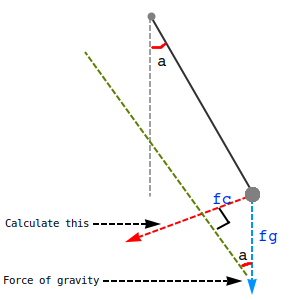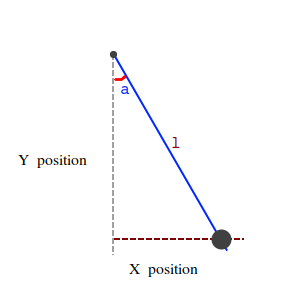Simple Pendulum
22 Nov 2019
Here's a simulation of some simple pendulums. I think what surprised me most about coding this was the realization that the mass of the
bob of the pendulum has NO say in its period. Only the length and the acceleration of gravity matter.
Sorry, your browser does not support Canvas.
| Variable | Value Range | Value |
| Gravity | 0.1 - 280 m/s |
Presets : |
| Damping | 0.900 - 1.000 | |
| Trace | ||
| FPS | ||
| Show/Hide | ||
I know that the demo above looks very busy. You can turn off or on the pendulums and other animations on the demo and then you'll be left with just this realization. That behind all the "busy-ness" are just two calculations. One is to calculate the position of the bob of the pendulum based on the force and the other is to calculate the force itself.
 |
On the image to the left, I did my best to explain the way to calculate the force on the bob of the pendulum. This is highlighted
as the red line in the image (fc).
We know the values of the following variables.
SIN(a) = force to calculate (fc) / force of gravity (fg); Thus fc = fg / SIN(a) This gives us the force (or acceleration) that acts on the pendulum. |
 |
Once we know the force, we know how fast or slow the angle changes. With the angle we can easily calculate the
position of the bob. The image on the left shows how. We know two values. The angle (a) and the
length (l). Using the SOHCAH method we calculate the position of the bob. X Position = SIN(angle) * length Y Position = COS(angle) * length |
Javascript Demos ▼
Here's a bunch of javascript... things I wrote over the years whenever time permitted.
Abhivadaye Generator
Game of Life
Anagram Finder
Deflection Demo
Break Out
Cycloids
Double Pendulum
Flocking
Fog fly through
Fractals
EV Savings
Target Finder
Bouncing Spheres
Horizontal Stars
Image Scanning
Pandemic Simulator
JSON Beautify
Julia Sets
Kaleidoscope
Kock Fractals
Lorenz Attractor
Mandlebrot Set
Meta Balls
Number Convert
Number Game
Forces on Objects
Particles & Nodes
Simple Pendulum
Perlin Noise
Poisson Disk
QuadTree Search
8 Queens Problem
Natural Flocking
Ripples
Set Demonstration
Sine Waves
Classic Snake
Starfield
Sierpinski Triangles
Super Shapes 2D
Tic Tac Toe
Voronoi Diagram
Who Moved My...